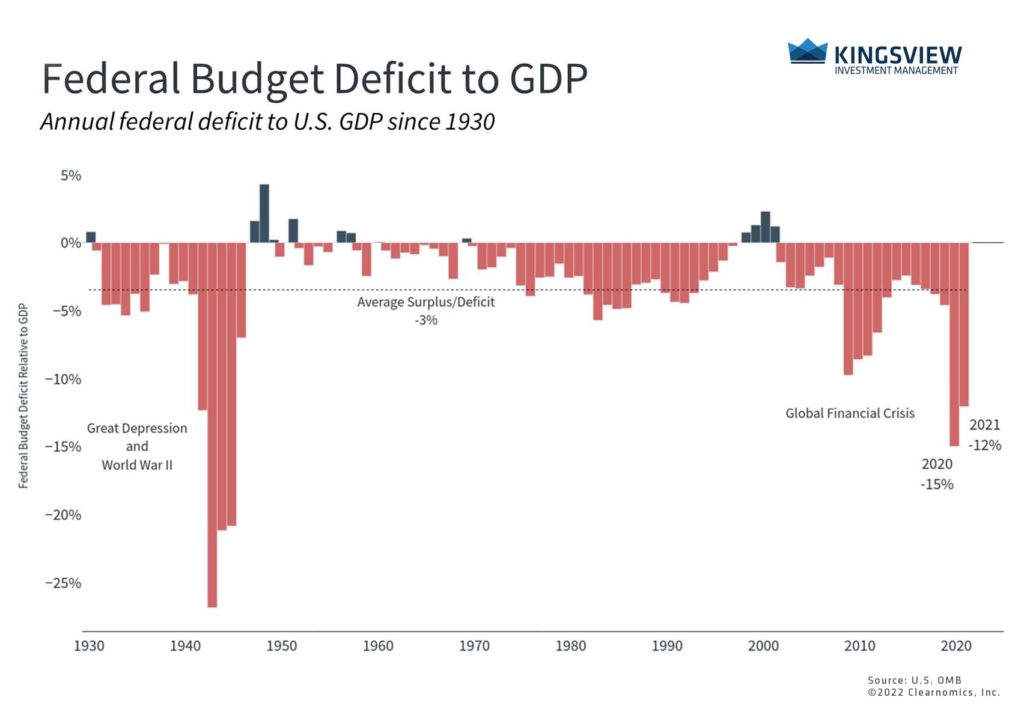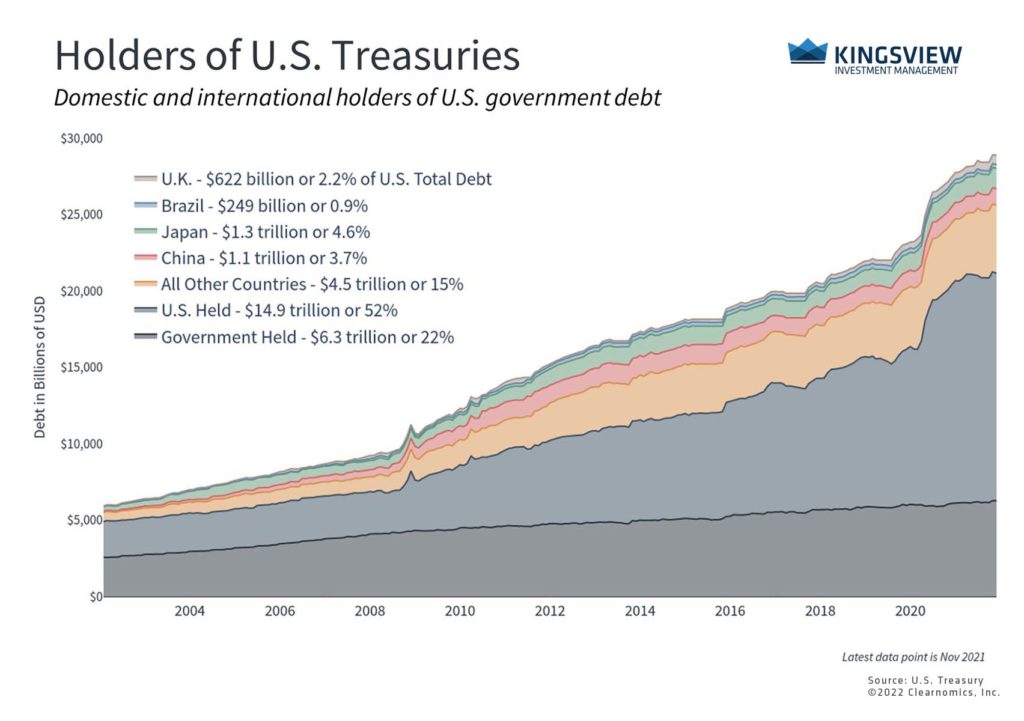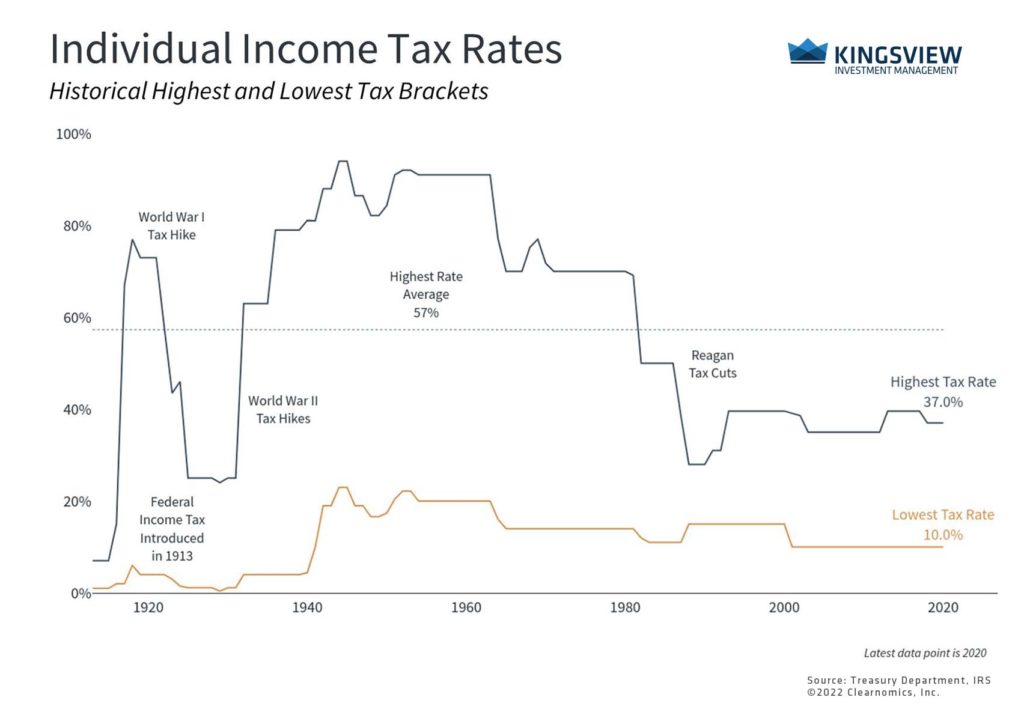Portfolio Manager Insights | Weekly Investor Commentary - 2.9.22
To download the commentary – click here.
The U.S. Treasury has reported that the national debt surpassed $30 trillion in 2021, a fact that has fueled headlines and concerns. This means that the federal debt has doubled over the past decade and, with very few exceptions, has grown nearly every year over the past century. This also adds to the recurring fiscal debates over the debt ceiling, avoiding government shutdowns, the size of economic stimulus bills, and more. How can investors view government spending with the right perspective and stay focused on what drives markets in the long run?
Naturally, the large and ever-growing national debt is a controversial topic that impacts the economy and markets in complex ways. At its core, budget deficits occur when the government spends more than it collects in taxes and other sources of revenue, which adds to the total debt. Even though tax revenues tend to increase as the economy grows (even without raising tax rates), they have been outpaced by spending over time. These expenditures have grown across “mandatory” programs such as Social Security and Medicare as well as “discretionary” items such as defense and education. The shortfall is funded by government borrowing, i.e., by issuing Treasury securities.
It’s important to distinguish between what should matter as investors and what might matter as citizens, voters and taxpayers. As individuals, many have strong personal and political views on government spending and taxation, and what it may mean for the country over the coming generations. However, this can be distinct from whether deficits directly or indirectly impact the economy and markets. From a portfolio perspective, investors typically worry about how the debt is measured, whether it will cause interest rates to rise, if it will drive up taxes, and more. Here are three facts to keep in mind on what the growing national debt does and doesn’t mean.
The federal deficit spiked during the pandemic

Key Takeaway:
- The federal deficit has remained high due to ongoing stimulus programs. While this can be alarming to some, history shows a clear pattern of deficit spending during crises. This then improves once the economy gets back on track.
First, while the dollar amount of the national debt and deficit are important, what matters more is their size relative to the economy. The fact that the national debt has grown significantly may be troubling in isolation, but the economy has also grown roughly 60% over the past decade. The annual budget deficit in particular is large in dollar terms and amounted to 12% of GDP in 2021. This is by no means a small percentage but there have been several periods across history – primarily during economic downturns and wars – when the government has been forced to spend at this level. History shows that, over time, this improves as the economy stabilizes, even if deficits don’t turn into surpluses.
The unfortunate reality is that deficit spending does not seem to be going away, with neither major party focusing on the issue. Thus, it’s important to consider what type of spending is driving the deficit higher. It’s no secret that, over the last two years, the skyrocketing national debt is primarily due to pandemic stimulus programs. Combined, the CARES Act and subsequent bills amounted to about $5 trillion in new government spending.
Most Treasuries are held within the U.S.

Key Takeaways:
- The distinction between total debt and net debt is an important one – the difference being the amount of debt held by the government itself.
- Additionally, the majority of Treasuries are still held by U.S. individuals and institutions. While international holders are growing in importance, we have not yet reached an inflection point.
Second, about two-thirds of the national debt is held either by the government itself or by U.S. citizens. The amount held by government entities is generally excluded by economists when considering the total size of the debt, since this is the equivalent of moving money from one pocket to the other. Thus, the many headline numbers that focus on total debt rather than “net debt” may not provide the most accurate picture.
That said, many investors worry that growing debt and deficit levels means that Treasuries could be less attractive in the future. In the extreme, this could hamper the government’s ability to roll its debt, possibly leading to skyrocketing interest rates. And while this is a possibility, there have not been signs of it yet. Even in 2011, when Standard & Poor’s downgraded the U.S. debt during the fiscal cliff standoff, investors didn’t sell their Treasuries – they rushed to buy more. Ironically, this is because U.S. debt securities are still the standard for stable, risk-free assets in the world.
Tax rates have fluctuated but markets have done well throughout

Key Takeaways:
- While most individuals do not wish for higher taxes, history shows that the stock market has performed well across different tax rate regimes. During the first half of the 20th century, there were many periods when the highest marginal rates were around 90%.
- Stock market returns were robust in the 1960s and earlier, just as they have generally been since the 1980s following the Reagan tax cuts.
In the near-term, interest rates could rise further due to government borrowing and the Fed beginning to “run off” its balance sheet. This would impact long-term interest rates more than Fed rate hikes, which could affect borrowing costs and valuations across the market. Of course, the Fed will do this while monitoring financial conditions.
Third, and perhaps most importantly, markets have done well regardless of the exact level of the government debt and taxes over the past century. As unintuitive as it might seem, the best time to invest over the past two decades has been when the deficit has been the worst. These periods represent times of economic crisis when the government is engaging in emergency spending, which tends to coincide with the worst points of the market. And while this isn’t exactly a robust investment strategy, it does underscore the importance of not over-reacting to fiscal policy in one’s portfolio.
Thus, the topic of the federal debt can be complex and controversial. As with many heated issues, it’s important for investors to separate their concerns and not react with their hard-earned savings or investments.
Historical references do not assume that any prior market behavior will be duplicated. Past performance does not indicate future results. This material has been prepared by Kingsview Wealth Management, LLC. It is not, and should not, be regarded as investment advice or as a recommendation regarding any particular security or course of action. Opinions expressed herein are current opinions as of the date appearing in this material only. All investments entail risks. There is no guarantee that investment strategies will achieve the desired results under all market conditions and each investor should evaluate their ability to invest for the long term. Investment advisory services offered through Kingsview Wealth Management, LLC (“KWM”), an SEC Registered Investment Adviser. (2021)
